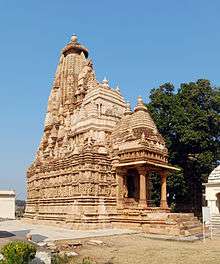Jain temples of Khajuraho

| Part of a series on |
| Jainism |
|---|
 |
|
Jain prayers |
|
Ethics |
|
Major figures |
|
Major sects |
|
Festivals |
|
Pilgrimages |
|
|
During the Chandela rule, many towns in Bundelkhand, including Khajuraho, were home to large and flourishing Jain communities. At Khajuraho the Jains apparently lived on the east side of town. A number of Jain temples from that period have survived in this part of Khajuraho in various states of preservation. Many Jain inscriptions from the Chandela period can be seen at Khajuraho.[1] All the Jain temples are now enclosed within a compound wall constructed in early 12th century, with the exception of the Ghantai temple. These temple are part of UNESCO World Heritage Site along with other temples in Khajuraho Group of Monuments.
Temples
Two of the large temples still stand in a good state of preservation.
Parshvanath Temple
This temple contains an inscription dating from 954 AD by its builder Pahila, mentioning donation of gardens and requesting future generations to safeguard the temple. It mentions Chandella Dhanga as the reigning king.[2]
A well known early magic square is found in this temple.[3]

| ||||||||||||||||
| transcription of the indian numerals |
This is referred to as the Chautisa (Thirty-four) Yantra, since each sub-square sums to 34.
Adinath Temple
The Adinath Jain temple contains an idol with an inscription dated to year 1027 during the rule of Chandella king Madanavarman.
Shantinath Temple
The Shantinath Temple is a modern composite structure that incorporates sections of several temples and has several shrines. The main section has a 15-foot-tall (4.6 m) idol of Lord Shantinath with an inscription of year 1028(V.S. 1085).
Ghantai Temple
The Ghantai Temple was built around 960 AD by Chandela kings of Khajuraho. This temple was dedicated to lord Rishabha as Chakreshwari is seen in this temple along with Nine planets and Gomukh yaksha.
Gallery
 Adinath Temple in Khajuraho
Adinath Temple in Khajuraho Parshvanath Temple in Khajuraho
Parshvanath Temple in Khajuraho Shantinath Temple in Khajuraho
Shantinath Temple in Khajuraho- Main Idol at Shantinath Jain Temple of height 15 feet, Khajuraho India
- Jain Temple at the back side of Shantinath Temple, Khajuraho India
 Parshvanath idol in Parshvanath Temple
Parshvanath idol in Parshvanath Temple Ruins of Ghantai Temple
Ruins of Ghantai Temple- Jain Museum, Khajuraho India
 Image of King Nabhi and Mata Marudevi at Jain Museum, Khajuraho
Image of King Nabhi and Mata Marudevi at Jain Museum, Khajuraho- Jain Museum, Khajuraho India
See also
References
External links
- Get Bundelkhand Jainism Place Information in Hindi on Bundelkhand Darshan
- Khajuraho Jain Temples
- Shri Digamber Atishay Kshetra, Khajuraho
